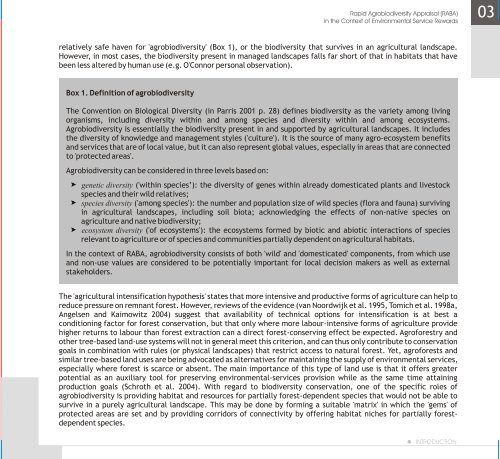Rapid Agrobiodiversity Appraisal (RABA) - Are you looking for one ...
Rapid Agrobiodiversity Appraisal (RABA) - Are you looking for one ...
Rapid Agrobiodiversity Appraisal (RABA) - Are you looking for one ...
Create successful ePaper yourself
Turn your PDF publications into a flip-book with our unique Google optimized e-Paper software.
<strong>Rapid</strong> <strong>Agrobiodiversity</strong> <strong>Appraisal</strong> (<strong>RABA</strong>)<br />
in the Context of Environmental Service Rewards<br />
relatively safe haven <strong>for</strong> 'agrobiodiversity' (Box 1), or the biodiversity that survives in an agricultural landscape.<br />
However, in most cases, the biodiversity present in managed landscapes falls far short of that in habitats that have<br />
been less altered by human use (e.g. O'Connor personal observation).<br />
Box 1. Definition of agrobiodiversity<br />
The Convention on Biological Diversity (in Parris 2001 p. 28) defines biodiversity as the variety among living<br />
organisms, including diversity within and among species and diversity within and among ecosystems.<br />
<strong>Agrobiodiversity</strong> is essentially the biodiversity present in and supported by agricultural landscapes. It includes<br />
the diversity of knowledge and management styles ('culture'). It is the source of many agro-ecosystem benefits<br />
and services that are of local value, but it can also represent global values, especially in areas that are connected<br />
to 'protected areas'.<br />
<strong>Agrobiodiversity</strong> can be considered in three levels based on:<br />
genetic diversity ('within species’): the diversity of genes within already domesticated plants and livestock<br />
species and their wild relatives;<br />
species diversity ('among species'): the number and population size of wild species (flora and fauna) surviving<br />
in agricultural landscapes, including soil biota; acknowledging the effects of non-native species on<br />
agriculture and native biodiversity;<br />
ecosystem diversity ('of ecosystems'): the ecosystems <strong>for</strong>med by biotic and abiotic interactions of species<br />
relevant to agriculture or of species and communities partially dependent on agricultural habitats.<br />
In the context of <strong>RABA</strong>, agrobiodiversity consists of both 'wild' and 'domesticated' comp<strong>one</strong>nts, from which use<br />
and non-use values are considered to be potentially important <strong>for</strong> local decision makers as well as external<br />
stakeholders.<br />
The 'agricultural intensification hypothesis' states that more intensive and productive <strong>for</strong>ms of agriculture can help to<br />
reduce pressure on remnant <strong>for</strong>est. However, reviews of the evidence (van Noordwijk et al. 1995, Tomich et al. 1998a,<br />
Angelsen and Kaimowitz 2004) suggest that availability of technical options <strong>for</strong> intensification is at best a<br />
conditioning factor <strong>for</strong> <strong>for</strong>est conservation, but that only where more labour-intensive <strong>for</strong>ms of agriculture provide<br />
higher returns to labour than <strong>for</strong>est extraction can a direct <strong>for</strong>est-conserving effect be expected. Agro<strong>for</strong>estry and<br />
other tree-based land-use systems will not in general meet this criterion, and can thus only contribute to conservation<br />
goals in combination with rules (or physical landscapes) that restrict access to natural <strong>for</strong>est. Yet, agro<strong>for</strong>ests and<br />
similar tree-based land uses are being advocated as alternatives <strong>for</strong> maintaining the supply of environmental services,<br />
especially where <strong>for</strong>est is scarce or absent. The main importance of this type of land use is that it offers greater<br />
potential as an auxiliary tool <strong>for</strong> preserving environmental-services provision while as the same time attaining<br />
production goals (Schroth et al. 2004). With regard to biodiversity conservation, <strong>one</strong> of the specific roles of<br />
agrobiodiversity is providing habitat and resources <strong>for</strong> partially <strong>for</strong>est-dependent species that would not be able to<br />
survive in a purely agricultural landscape. This may be d<strong>one</strong> by <strong>for</strong>ming a suitable 'matrix' in which the 'gems' of<br />
protected areas are set and by providing corridors of connectivity by offering habitat niches <strong>for</strong> partially <strong>for</strong>estdependent<br />
species.<br />
INTRODUCTION

















![CynefinFramework final [Read-Only]](https://img.yumpu.com/19017304/1/190x135/cynefinframework-final-read-only.jpg?quality=85)